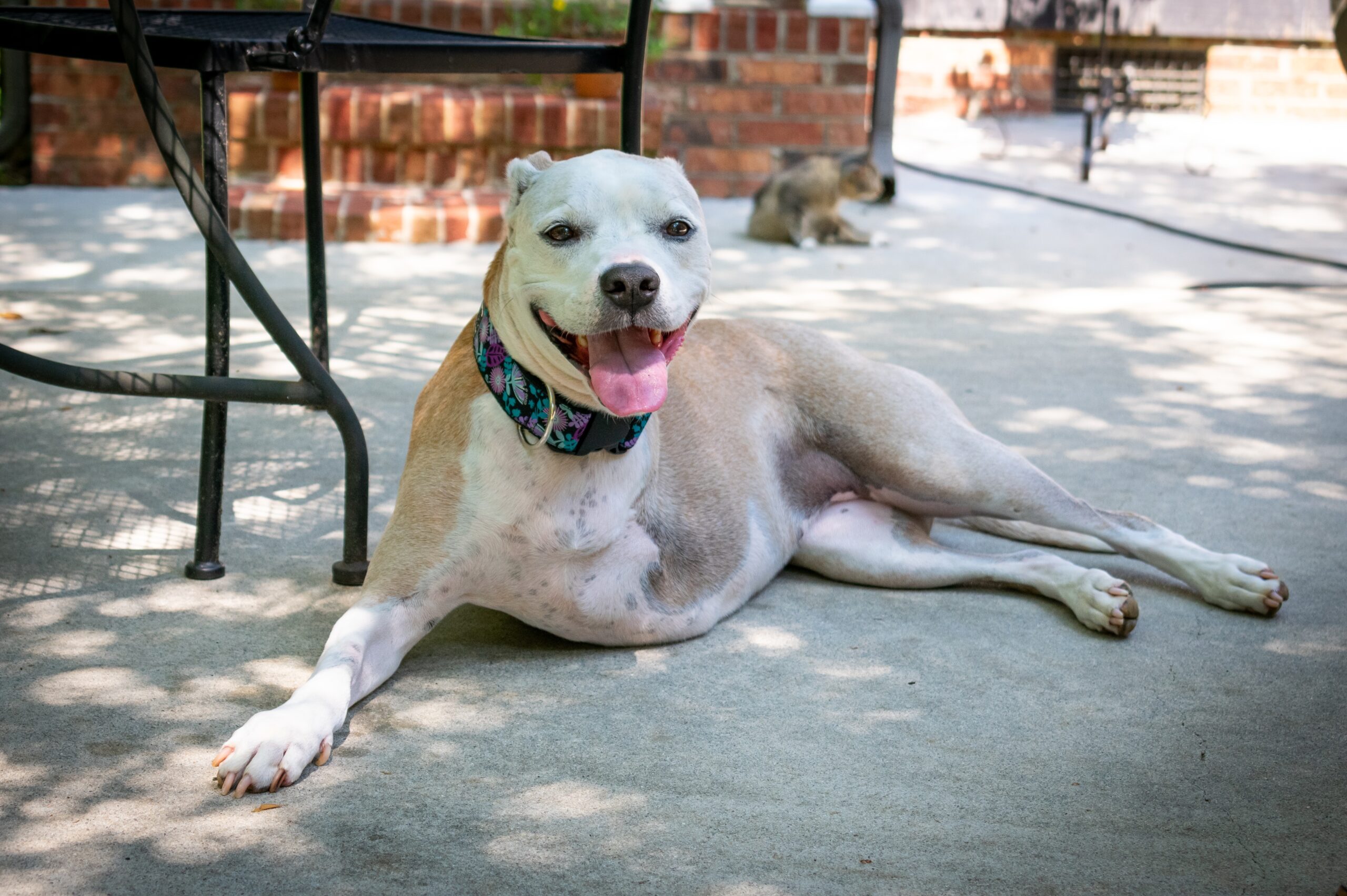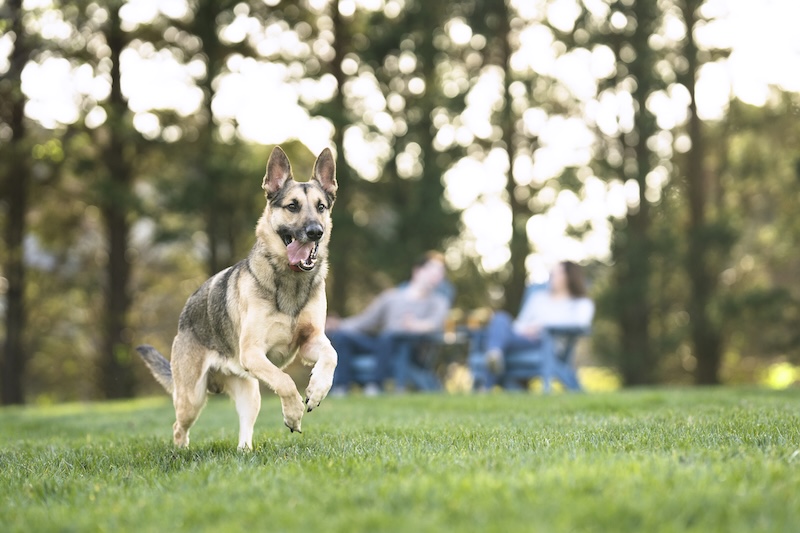What Is Osteosarcoma in Dogs: Cause, Symptoms, and Treatment


What Is Osteosarcoma in Dogs: Cause, Symptoms, and Treatment
Table of Contents
Osteosarcoma in dogs is the most common type of bone cancer in canines, affecting the bones in the legs, such as the front leg joints. The osteosarcoma, or aggressive leg condition, leads to the formation of hard lumps that are visible around the affected joints.
The cause of an osteosarcoma hard lump on a dog’s front leg joint is believed to be genetics, rapid growth rates in large breed dogs, and previous bone injuries.
Symptoms of osteosarcoma dog conditions include noticeable swelling, persistent lameness, and pain in the affected limb.
Treatment options involve surgery, such as limb amputation of the tumor on dog legs, and chemotherapy to manage the disease and improve the dog’s quality of life.
What is osteosarcoma in dogs?
Osteosarcoma in dogs is a malignant bone tumor that targets the long bones in the legs. The type of cancer is known for its aggressive nature, rapidly destroying healthy bone tissue and causing significant pain and lameness in the affected limb.
Osteosarcoma in dogs presents as a hard lump near the joints, such as the elbow, and is referred to as “dog elbow cancer.” It impairs a dog’s mobility. Osteosarcoma is common in large and giant breed dogs, though it occurs in any breed.
What are other terms for osteosarcoma in dogs?
Other terms for osteosarcoma in dogs are bone tumor or bone cancer, highlighting its characteristic of originating in the bones. “Osteosarcoma (OS) is a primary bone tumor affecting both dogs and humans,” according to the study by Arnold, L., Hendricks-Wenger, A., Coutermarsh-Ott, S., Gannon, J., Hay, A., Dervisis, N., Klahn, S., Allen, I., Tuohy, J., & Vlaisavljevich, E. titled “Histotripsy Ablation of Bone Tumors: Feasibility Study in Excised Canine Osteosarcoma Tumors,” 2021.
Osteosarcoma is a bone cancer in dogs and is described using terms such as osteogenic sarcoma, a name derived from the cells and tissue involved in the tumor’s formation. Veterinarians refer to osteosarcoma as a malignant neoplasm due to its aggressive and life-threatening nature.
How does osteosarcoma develop in dogs?
Osteosarcoma develops in dogs when abnormal cells in the bone multiply uncontrollably, forming a tumor that leads to severe complications and pain. Dogs typically develop osteosarcoma around 7 to 9, although it occurs in younger dogs, particularly larger breeds.
The abnormal cells undergo genetic mutations, disrupting the normal cell cycle regulation and growing uncontrollably. Osteosarcoma’s proliferation forms a mass within the bone, weakening its structure and causing pain for the dog. The tumor progresses and invades nearby tissues, metastasizing to other organs via the blood or lymph.
How common is osteosarcoma in dogs?
Osteosarcoma is common in dogs, especially in giant breed dogs. The condition is the most frequently diagnosed primary bone tumor in the canine population. “Osteosarcoma is the most common primary malignant bone tumor in dogs, representing 80-85% of primitive bone tumors and 3-4% of all canine tumors,” according to the study by Leonardo, L., Laura, P., & Serena, B. titled “miR-1 and miR-133b expression in canine osteosarcoma,” 2018.
Osteosarcoma is less common in cats and puppies than in adult dogs. The disease occurs rarely in cats, and while it affects young dogs, it is predominantly a disease visible in middle-aged to older dogs.
What are the common locations for osteosarcoma in dogs?
The most common locations for osteosarcoma in dogs are the knee and shoulder joints, where the rapid growth of the tumor leads to visible swelling and lameness. “Appendicular locations are most frequently involved in osteosarcoma in dogs, with large to giant breed dogs being commonly affected,” according to the study by Morello, E., Martano, M., & Buracco, P. titled “Biology, diagnosis, and treatment of canine appendicular osteosarcoma: similarities and differences with human osteosarcoma,” 2011.
Dog elbow cancer is osteosarcoma affecting the elbow joint, which causes noticeable swelling and pain. Osteosarcoma develops in other bones, including the ribs, pelvis, and vertebrae, although this is less common.
Which breeds are more prone to developing osteosarcoma?
The breeds that are more prone to developing osteosarcoma are listed below.
- Great Dane: Great Danes are among the most susceptible breeds to osteosarcoma due to their large size and towering height.
- Rottweiler: Rottweilers have a high incidence of osteosarcoma related to their muscular build and active nature.
- Irish Wolfhound: Wolfhounds are one of the tallest dog breeds, and their large and rapidly growing bones contribute to their higher risk of developing osteosarcoma.
- Greyhound: Greyhounds are prone to osteosarcoma due to their genetics and slender bone structure.
- Saint Bernard: Saint Bernard’s giant size and growth rates make them susceptible to bone cancer.
- Newfoundland: Newfoundlands are at risk for osteosarcoma due to their large body mass and bone growth patterns.
- Labrador Retriever: Labradors are prone to osteosarcoma, though not as much as giant breeds.
- Golden Retriever: Golden Retrievers have a body size similar to that of Retrievers and are thus at risk for osteosarcoma, with genetic factors playing a role.
- Doberman Pinscher: Doberman Pinschers have a predisposition to osteosarcoma due to their size and genetics.
- German Shepherd: German Shepherds are a large breed at higher risk of developing osteosarcoma.
What does osteosarcoma in dogs look like?
Osteosarcoma in dogs looks like swelling or a mass on the limb, with lameness, pain, and a noticeable change in the dog’s gait.
What are the causes of osteosarcoma in dogs?
The causes of osteosarcoma in dogs are listed below.
- Genetic Predisposition: Large and giant breeds have a higher genetic predisposition to developing osteosarcoma. The commonality indicates a hereditary component to the disease.
- Rapid Growth Rates: Dogs that grow quickly to large sizes are susceptible to osteosarcoma. Rapid bone growth and increased bone turnover contribute to the risk of developing cancerous cells that cause tumors.
- Previous Bone Injuries: Trauma or previous injuries to bones increase the risk of osteosarcoma. The healing process from fractures or other significant bone damage triggers abnormal cell growth.
- Environmental Factors: Exposure to environmental factors, such as radiation or carcinogenic chemicals, influences the development of osteosarcoma, although this is less understood in dogs than in humans.
- Age: Osteosarcoma occurs at any age, but it is more common in middle-aged to older dogs. Pet owners asking, “What causes lymphoma in dogs?” must note that the condition occurs in younger dogs, particularly in large breeds.
- Sex: Male dogs are more prone to osteosarcoma than female dogs, though the reasons for the predisposition are unclear.
- Bone Inflammation: Chronic inflammation or infections in the bone contribute to the development of osteosarcoma, as ongoing inflammation leads to cellular changes and mutations.
What are the symptoms of osteosarcoma in dogs?
The symptoms of osteosarcoma in dogs are listed below.
- Lameness: Persistent or intermittent limping in the affected leg, which worsens over time.
- Swelling: Noticeable swelling or a hard lump around the affected bone or joint, seen in the limbs, are signs of bone cancer in dogs back leg areas.
- Pain: Apparent pain in the affected area, which causes the dog to be reluctant to move or bear weight on the limb.
- Fractures: Pathological fractures (breaks in the bone due to weakening from the tumor) occur with minimal trauma or everyday activities.
- Decreased Activity: Dogs exhibit reduced willingness to exercise or play, lethargy, and general reluctance to engage in normal activities.
- Loss of Appetite: Symptoms of bone cancer in dogs include reduced food interest, leading to weight loss.
- Behavioral Changes: Changes in behavior due to pain, such as increased irritability, restlessness, or withdrawal, are visible.
When do symptoms of osteosarcoma usually occur in dogs?
Symptoms of osteosarcoma in dogs usually occur in middle-aged dogs of 5 – 10 years old. The symptoms manifest in the later stages of the disease when the tumor begins to affect the surrounding bone and tissues. “Osteosarcoma symptoms in dogs usually occur in 5 to 9 years old, with a peak around 7 years, but can also be observed in young dogs at 1 year of age,” according to the study by Lima, R., Gomes, M., Negreiros, V., & Nascimento, L. titled “Osteossarcoma canino: Relato de caso,” 2017. Symptoms include lameness, swelling, and pain in the affected limb.
What are the risk factors for osteosarcoma in dogs?
The risk factors for osteosarcoma in dogs are listed below.
- Breed: Large and giant breeds are at higher risk, including Great Danes, Rottweilers, Irish Wolfhounds, Greyhounds, Saint Bernards, Newfoundlands, Labrador Retrievers, Golden Retrievers, Doberman Pinschers, and German Shepherds.
- Size and Weight: Larger dogs with greater body mass and longer bones are prone to developing osteosarcoma.
- Age: Middle-aged to older dogs are more commonly affected, though it occurs in younger dogs of large breeds.
- Sex: Male dogs have a higher risk of developing osteosarcoma compared to female dogs.
- Previous Bone Injuries: Trauma or previous bone injuries, such as fractures, increase the risk of osteosarcoma. The healing process and increased cellular activity in the bone contribute to cancer development.
- Genetic Factors: Hereditary factors play a role in the likelihood of developing osteosarcoma. Dogs from lines with a history of bone cancer are at greater risk.
- Bone Inflammation: Chronic bone inflammation or infections lead to changes in bone cells, increasing the risk of cancer.
- Environmental Factors: Exposure to radiation or carcinogenic chemicals increases the risk of bone cancer, though this is less evident in dogs than in humans.
What are the complications of osteosarcoma in dogs?
The complications of osteosarcoma in dogs are listed below.
- Metastasis: Osteosarcoma is aggressive and metastasizes (spreads) to other body parts, such as the lungs. Metastatic tumors affect lung function and overall health.
- Pathological Fractures: The cancer weakens the affected bone, making it susceptible to fractures with minimal trauma.
- Pain and Lameness: Persistent pain and lameness due to the tumor’s growth and bone destruction are common.
- Surgery Side Effects: Amputation or limb-sparing surgery leads to complications such as infection, poor wound healing, and mobility issues.
- Chemotherapy Side Effects: Side effects of chemotherapy include nausea, vomiting, loss of appetite, diarrhea, and a decreased white blood cell count, which increase the risk of infections.
- Radiation Therapy Side Effects: Side effects include skin irritation, hair loss at the treatment site, and fatigue.
- Reduced Quality of Life: The combined effects of the disease and its treatment reduce the dog’s quality of life, impacting their ability to perform everyday activities.
- Respiratory Issues: Cancer that spreads to the lungs causes respiratory problems, including coughing, difficulty breathing, and decreased exercise tolerance.
- Secondary Infections: Weakened immune function due to cancer or its treatments makes dogs susceptible to secondary infections.
- Weight Loss and Muscle Atrophy: Pain, decreased activity, and side effects of treatment cause dogs to experience weight loss and muscle atrophy.
How do veterinarians diagnose osteosarcoma in dogs?
Veterinarians diagnose osteosarcoma in dogs through a physical examination and X-rays to detect abnormal bone growths or lesions. Suspicious areas are identified on the X-rays. A biopsy is recommended to diagnose osteosarcoma definitively. “Osteosarcoma in dogs is diagnosed using X-rays and biopsy, with surgical resection followed by chemotherapy,” according to the study by Chun, R., & Lorimier, L. titled “Update on the biology and management of canine osteosarcoma,” 2003.
How long can a dog typically live after being diagnosed with osteosarcoma?
A dog can typically live up to one year after being diagnosed with osteosarcoma. Most dogs live for several months to a year with appropriate treatment, including surgery and chemotherapy. “The median survival time for dogs with osteosarcoma is 321 days after diagnosis, with 35.4% of the dogs alive at 1 year,” according to the study by Bergman, P., Macewen, E., Kurzman, I., Henry, C., Hammer, A., Knapp, D., Hale, A., Kruth, S., Klein, M., Klausner, J., Norris, A., McCaw, D., Straw, R., & Withrow, S. titled “Amputation and carboplatin for treatment of dogs with osteosarcoma: 48 cases (1991 to 1993),” 1996.
Where can you seek a diagnosis for osteosarcoma in dogs?
You can seek a diagnosis for osteosarcoma in dogs at animal hospitals and clinics. “Diagnostic modalities used for primary bone tumors in veterinary medicine include radiographs, bone biopsy, CT, nuclear medicine, and MRI, with chemotherapy sometimes being used depending on the tumor’s aggressiveness,” according to the study by Vanel, M., Blond, L., & Vanel, D. titled “Imaging of primary bone tumors in veterinary medicine: which differences?” 2013.
The facilities are staffed with trained professionals specializing in oncology and orthopedic surgeries for early stage bone cancer in dogs x-ray. Pathologists examine biopsy samples to confirm the presence of cancer cells.
What is the prognosis for dogs diagnosed with osteosarcoma?
The prognosis for dogs diagnosed with osteosarcoma is mixed, with an average survival duration of 2 – 12 months. “Canine osteosarcoma is an aggressive tumor with poor prognosis, with median survival times ranging from 3 months to 1 year, and 20% of dogs survive for >2 years following diagnosis,” according to the study by Selvarajah, G., & Kirpensteijn, J. titled “Prognostic and predictive biomarkers of canine osteosarcoma,” 2010.
The prognosis is poor without treatment, with a median survival time of 1-2 months. Treatment that includes surgery and chemotherapy extends the survival time to 10-12 months. Some dogs live longer if the disease is caught early and aggressively treated.
What are the treatment options for osteosarcoma in dogs?
The treatment options for osteosarcoma in dogs are listed below.
- Amputation: Surgical removal of the affected limb is recommended to alleviate pain and eliminate the primary tumor. Dogs adapt to life on three legs, and amputation is followed by adjuvant therapies to address micrometastases.
- Limb-Sparing Surgery: Limb-sparing surgeries remove the tumor while preserving as much healthy bone and tissue as possible. The surgery is followed by reconstructive techniques such as bone grafts or prosthetic implants.
- Chemotherapy: Adjuvant chemotherapy is recommended following surgery to target remaining cancer cells and reduce the risk of metastasis. The treatment palliatively manages metastatic disease and improve quality of life.
- Radiation Therapy: Radiation therapy is a primary treatment for tumors in locations where surgery is not feasible or as a palliative treatment to relieve pain and control tumor growth.
- Pain Management: Pain management involves medications such as non-steroidal anti-inflammatory drugs (NSAIDs), opioids, and other analgesics to keep the dog comfortable and maintain a good quality of life.
- Palliative Care: Palliative care provides comfort through pain management, nutritional support, and supportive care measures for dogs with advanced or metastatic disease.
How can one improve a dog’s immune system during osteosarcoma treatment?
One can improve a dog’s immune system during osteosarcoma treatment by providing a balanced diet, regular exercise, and supplements. A diet rich in antioxidants, vitamins, minerals, high-quality protein, and healthy fats maintains energy and muscle mass. Regular exercise tailored to the dog’s abilities strengthens muscle tone and improves overall health without causing stress on the dog’s limbs. Supplements such as omega-3 fatty acids, probiotics, and vitamins E and C improve a dog’s immune system and reduce inflammation in the knees and shoulders.
















